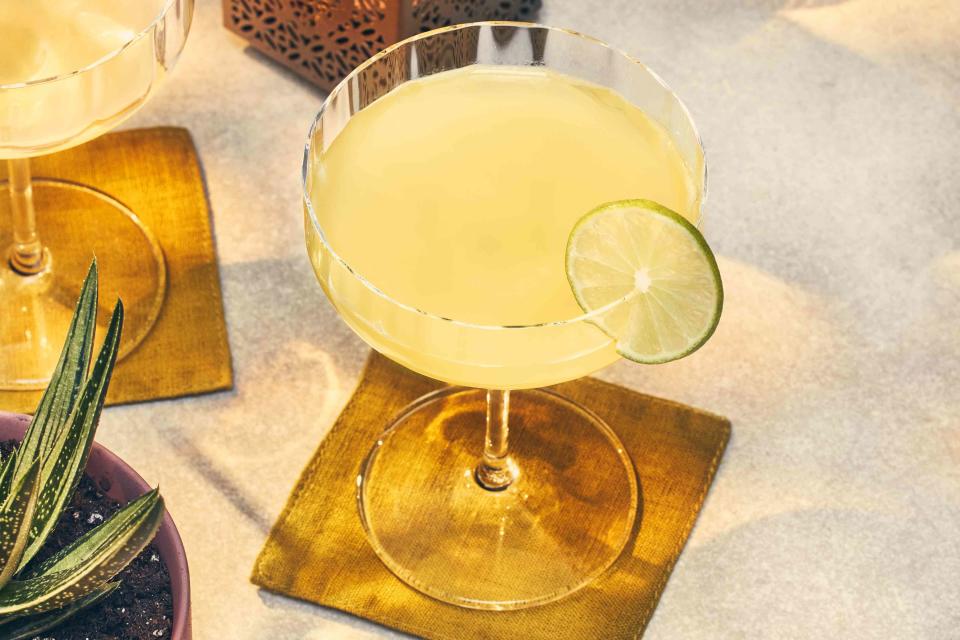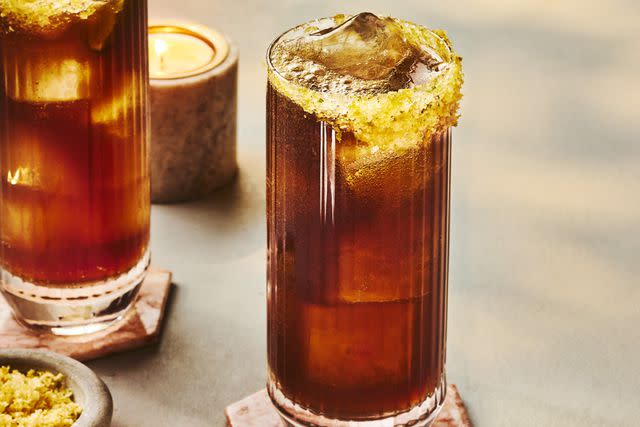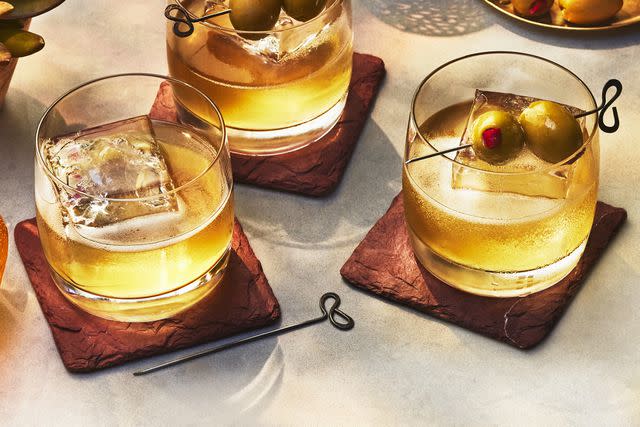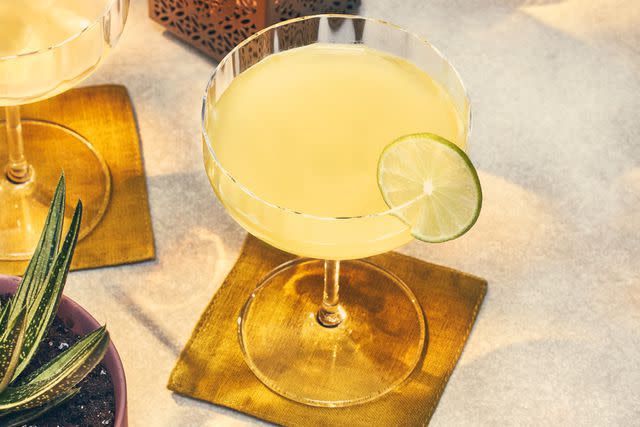Mexico Is the Most Exciting Place in the World to Drink Right Now
Cocktail bars in Mexico City, Tijuana, Guadalajara and beyond prove why Mexico slings some of the best drinks in the business.

Greg Dupree / Food Styling by Emily Nabors Hall / Prop Styling by Christina Daley
Order a margarita at Brujas, a spectrally lit cocktail bar at the edge of Mexico City's Parque Rio de Janeiro, and you'll likely be gently nudged toward something like the Ayuujk. Named for the indigenous languages of Oaxaca's Mixe region, the combination of mezcal, corn liqueur, housemade cacao bitters, and Mexican white wine infused with cacao and pixtle (a substance found inside the pit of the mamey fruit) is inspired by Yásnaya Aguilar, a Mixe writer, translator, and linguistic rights activist who is one of many heroines cited on the cocktail menu. Deeply Mexican in both ingredients and concept, Brujas' approach illustrates the combination of innovation and tradition that's made Mexico one of the most exciting cocktail scenes in the world.
Related: Sotol, Bacanora, and Raicilla Are the Agave Spirits to Try Right Now
"It's essential to celebrate native Mexican ingredients, and incorporate them into modern mixology," says Fabiola Padilla, owner and beverage director at Bekeb in San Miguel de Allende. Her inspiring cocktails pair a Mexican base spirit—not just tequila and mezcal but raicilla, sotol, and local gins and whiskeys—with a highlighted local ingredient, such as cactus fruit, tomatillo, fermented mesquite honey, or the tree resin copal.
The Aguamiel combines pulque (spontaneously fermented agave sap) from her uncle's ranch—fermented until it reaches her desired strength for cocktail use—with pox, a kind of moonshine from Chiapas state, plus cacao, coconut, and Fino sherry. It shows how the country's cocktail scene is now matching its fêted food scene in terms of creativity and tradition. "This wide variety of ingredients and flavors is what brings such complexity to Mexican cuisine, and our cocktails should be just as distinctive," says Padilla.
"The emergence of modern Mexican mixology can be traced to the 2011 opening of Mexico City's Limantour. But the speed and degree of innovation that would happen in the following years was breathtaking. "
The emergence of modern Mexican mixology can be traced to the 2011 opening of Mexico City's Limantour, which started modestly with drinks inspired by the international cocktail scene, and the occasional startling Mexican ingredient (for instance, the bar’s influential Margarita al Pastor with chile serrano, cilantro, basil, and pineapple). But the speed and degree of innovation that would happen in the following years was breathtaking.
The mezcal boom had shown the diversity of agave spirits, but the Casa Lumbre distillery soon broadened the scope of Mexican spirits beyond agave, first with the hugely popular Ancho Reyes chile liqueur in green (chile poblano) and red (chile ancho) versions, then with a corn whiskey (Abasolo), a border-straddling gin (Las Californias), a corn liqueur (Nixta), and the new Alma Finca, based on various citrus and their flowers—a kind of ultra-aromatic cousin to Cointreau.
Today you can find white (unaged) heirloom corn whiskeys from the states of Michoacán, Guanajuato, Oaxaca, Baja California, and Estado de Mexico, ron agrícola (aka rhum agricole), and over a dozen gins with Mexican botanicals, all of which show the vastness of the Mexican landscape in each bottle.
Related: The 5 Best Sipping Tequilas You Can Actually Afford
Take, for instance, Armónico gin, which uses a base of corn alcohol with 32 botanicals, including native ones like cempasúchil (Mexican marigold), canela (Mexican cinnamon), key lime, damiana (a wild shrub), and night-blooming jasmine.
"Our master distiller Andrés Valverde and I wanted to make a London Dry gin but with Mexican ingredients," says Juan Carlos Delgado of La Insoportable distillery, which makes Armónico. "Mexico’s various regions have incredible diversity in terms of ingredients, flavors, dishes, and traditions, which is why we have such enormous potential not just for agave spirits and fruit liqueurs but also non-traditional spirits like gin, whisky, and vodka."
""Just as Japan went from being perceived as only making sake to being acclaimed for its whiskeys, Mexico is no longer just tequila and mezcal." — Juan Carlos Delgado, CEO, La Insoportable"
Tourists are helping to fuel the demand for cocktails with a sense of place. Bar manager Joshua Monaghan, who helped turn Fifty Mils, the bar at Mexico City's Four Seasons Hotel, into a globally-acclaimed cocktail destination, now oversees Zapote Bar at the exclusive Rosewood Mayakoba resort on the Riviera Maya.
"Guests aren't just looking for any cocktail with tequila or mezcal, they want a story," he says. "When they understand why a certain cocktail came together in a certain place, that's when they make a deeper connection with Mexico."
At Four Seasons Tamarindo, an oceanfront resort in Jalisco state's Costalegre, whose culinary commitment extends to a 34-acre organic farm and harvesting their own sea salt, Director of Mixology Iván Torres uses hyper-local housemade products such as a bitters made with raicilla and foraged guamuchil fruit. "Even if clients aren't paying attention, we think it's important," he says.
Related: 20 Top International Hotel Bars, According to the Experts
And with the massive influx of post-pandemic tourism to Mexico, flavors here are starting to impact global cocktail culture. Take, for instance, NYC’s super-hot Superbueno, which features cocktails such as a Mole Negroni, made with fat-washed Mezcal and xocolati bitters, or its Improved Batanga, a heady mix of blanco tequila, fernet, lime juice, and cola (recipe, p.XX), or Mirate in Los Angeles, where you can find the El Yaki, which mingles papaya, bacanora, lime juice, and xtabentun liqueur.
"Just as Japan went from being perceived as only making sake to being acclaimed for its whiskeys, Mexico is no longer just tequila and mezcal," says Armónico's Delgado. "For us, Mexican ingredients and spirits are a matter of pride and inspiration, but they're expanding the possibilities for cocktails in the rest of the world, too."
Top Mexican Cocktail Bars
Aruba Day Drink, Tijuana
Aruba proves that serious mixology and playful irreverence can co-exist, in a sunny and lively space which showcases the fun and creativity that sets Tijuana apart.
Baltra, Mexico City
This diminutive bar off lush Plaza Iztaccíhuatl has an unusual Charles Darwin theme that helps reiterate the evolution of Mexico's cocktail scene.
Bekeb, San Miguel de Allende
Enjoy panoramic rooftop views from Fabiola Padilla's bustling bar (named for the Tzotzil word for "seed") that is deeply Mexican in concept and crystal clear in execution.
Brujas, Mexico City
The cauldrons at this semi-subterranean witch-themed bar contain some of the country's most inventive cocktails, many with savory and herbal profiles that reflect Mexico's culinary traditions.
De La O Cantina, Guadalajara
Traditional cantina vibes meet Hawaiian tiki dive at this cool spot that offers "Guadalatiki" cocktails with ingredients like house-made lime falernum and pumpkin-seed orgeat.
Selva, Oaxaca
At Selva, traditional Oaxacan ingredients and techniques meet international partners, as in the "Bosque de Niebla" cocktail of local mezcal with the Oaxacan smoked chile paste chintextle, ponzu, and Punt e Mes.
Zapote Bar, Riviera Maya
Even non-guests are welcome at this cocktail haven in one of the country's most exclusive resorts, whose weekly Martes de Locales series invites eminent guest bartenders each Tuesday.
Batanga

Greg Dupree / Food Styling by Emily Nabors Hall / Prop Styling by Christina Daley
This cocktail proves why tequila and coke belong together. It was invented in the 1960s by a restaurant owner in Mexico who named it after a customer who was “batanga” — slang for “thick in the middle” — aka “stout in appearance.” The Batanga has sweet and tart flavors with a touch of earthiness from the tequila; it comes together in a glass in minutes and can be easily scaled up for a crowd.
Coconut Water Mezcal Spritz (Yax Cha)

Greg Dupree / Food Styling by Emily Nabors Hall / Prop Styling by Christina Daley
Sweet, smoky, and slightly spicy, this mezcal-based spritz is made for warm-weather sipping. At Zapote Bar, located in the Rosewood Mayakoba resort in Playa del Carmen, bar director Joshua Monaghan calls this cocktail the Yax Cha after the Mayan word for mamey, the fruit that grows on the zapote tree which inspired the bar's name.
Mexican Daiquiri

Greg Dupree / Food Styling by Emily Nabors Hall / Prop Styling by Christina Daley
The Mexican Daiquiri features two types of rum and a simple syrup brightened with fresh lime juice for a sweet and tart kick. Grapefruit and celery bitters balance out the refreshing cocktail with a touch of fragrant complexity.
For more Food & Wine news, make sure to sign up for our newsletter!
Read the original article on Food & Wine.

 Yahoo Lifestyle
Yahoo Lifestyle 
